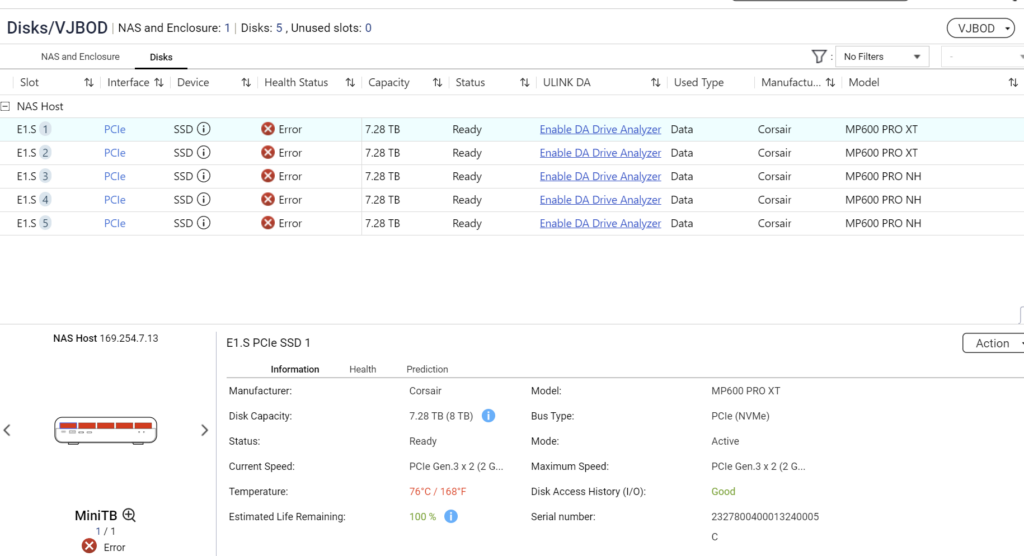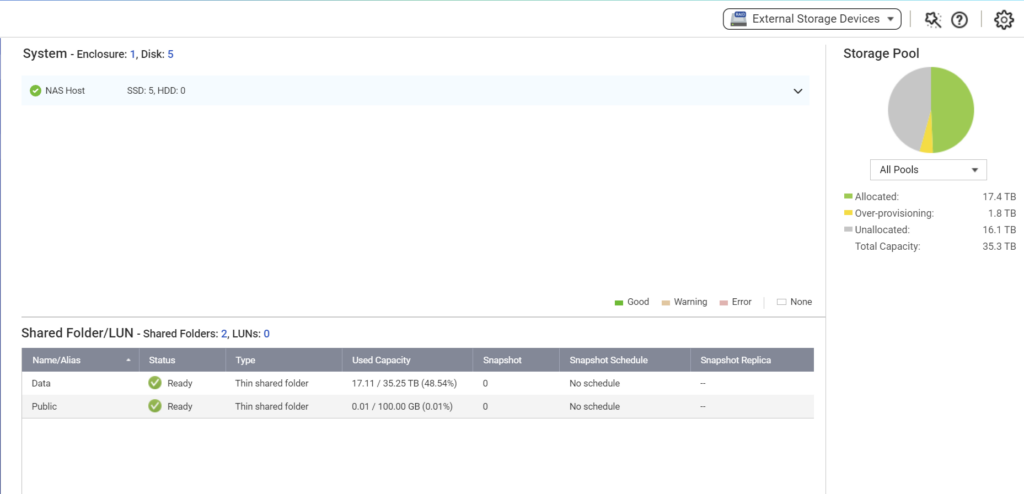Don’t you just love those NAS model numbers? The QNAP TBS-h574TX-i5-16G-US is a Network Attached Storage (NAS) box that has slots for five hot-swappable E1.S Solid State Disk (SSD) modules. It comes with adapters so that you can use M.2 2280 SSDs, which are more available now than E1.S drives. The NAS has two Thunderbolt 4 ports, a 2.5 GbE port, a 10 GbE port, and a few USB ports. The industrial design is a step up for QNAP:
You can see the AC/DC converter on top of the NAS. I initially hooked it up to my workstation using the back-panel Thunderbolt port. During the installation procedure, the Network OS (Hero) complained that it couldn’t find the network time server and that it couldn’t do any firmware updates. I plugged in a link between my desktop Ethernet switch and the 10 GbE port on the back of the NAS, and all was well. I configured 5 8TB M.2 drives as a striped array.
Initial performance testing wasn’t very encouraging:
But GoodSync turned in good numbers:
The NAS has thermally controlled fans. They are normally quiet, but two of them rev up to about 10,000 rpm after a few minutes of 20 Gb/s writes.
During the loading of about 16 TB of data onto the NAS, the drives got too hot for the NOS once:
But the NOS stopped complaining after I let them cool down:
There is not room on the hot-swap sleds for much in the way of an SSD heatsink. I just put the SSDs in bare. E.1S drives are supposed to have better heat dissipation ability than bare M.2 drives. But the overheating that I experienced is not something I’d expect either updating backed up information on the SSD array or using it directly from the workstation.
The whole out of box experience was even better than the usual smooth QNAP norm. I am quite happy with this NAS.
An hour after I wrote the above glowing review, disaster struck:
It seems unlikely that 3 SSDs would all fail at the same time. I tried reseating one of the SSDs. No joy. I tried rebooting, and the NAS hung. I powered the NAS down from the front panel. I restarted it.
I logged into the restarted NAS. I scanned the the three SSDs with R/W errors for bad blocks. The system came up clean.
There is now a new NOS version available. I upgraded to it.
Now the system is happy:
But QFinder can’t see the Thunderbolt port:
I plugged a Thunderbolt SSD into the Thunderbolt port on the workstation using the same TB4 cable, and the workstation can see the files just fine. So the Thunderbolt issue is a problem with the NAS. I have read that in the past FW updates on QNAP NAS’s have resulted in Thunderbolt connectivity issues. I opened a trouble ticket with QNAP on this. The tech asked me to send in the logs. I did. He asked if the front panel TB connection on the NAS worked. I tested it and it does not. After some back and forth, including pictures of the Thunderbolts cables, they scheduled a remote desktop session for Tuesday the 30th.
Result of the remote desktop session:
Problem Description :
Unable to connect via Thunderbolt to the QNAP.Steps performed :
– Connected to both thunderbolt ports
– Checked to see if any logs were generated – connection statusNext:
– QNAP : Submit escalation report to review the issue.
Another week has passed, with no progress. I downgraded the OS in the NAS, but that didn’t help. QNAP asked for another set of logs. They say an escalation team is working on the issue, but nobody from that team has contacted me. My latest request for status information has gone unanswered.
I now have a status report of sorts:
Our escalation team advised that they will be trying to replicate the issue but need to get one of these units from factory. It’s still under processing.
I think they’re hoping I lose patience and go away. That could in fact happen.
Grasping at straws here, I rebooted the workstation. The Thunderbolt port came up. I shut down the NAS, added some heatsinks to the M.2 SSDs, and started it again. No Thunderbolt connection.









Leave a Reply